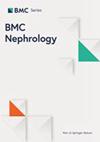动静脉瘘动脉瘤对英国透析人群血管通路认知的影响
IF 2.2
4区 医学
Q2 UROLOGY & NEPHROLOGY
引用次数: 0
摘要
越来越多的人认识到,以临床为导向的结果衡量标准缺乏对患者重要因素的考虑。新出现的指南机构主张采用更加以患者为中心的方法。自体动静脉瘘(AVF)中的动脉瘤可能会被认为有碍观瞻,并不断提醒患者他们对透析的依赖。然而,这些动脉瘤对患者感受的影响此前尚未见报道。2017 年 4 月至 18 月期间,作为质量改进项目的一部分,我们通过结构化访谈对十家透析单位的血液透析患者进行了血管通路问卷调查(VAQ)。对动脉瘤性动静脉瘘患者亚群(根据 Valenti 等人的分类方法进行分类)的数据进行了回顾性评估,并与更广泛的患者群进行了比较。研究收集了 539 名患者(中位年龄:66 岁;59% 为男性)的数据,其中 195 人(36%)患有动脉瘤性动静脉瘘,最常见的是 2 型形态(插管部位)(75%)。研究发现,动静脉瘘的持续时间与动脉瘤的发展显著相关,估计一年、五年和十年后的可能性分别为 11%、43% 和 61%。有趣的是,糖尿病患者发生动脉瘤的几率明显低于非糖尿病患者(25% 对 43%,P < 0.001)。VAQ总分在动脉瘤状态(p = 0.816)或形态类型(p = 0.277)方面没有明显差异。不过,动脉瘤性动静脉瘘患者对其动静脉瘘外观的关注度明显高于其他患者(p < 0.001)。尽管如此,动脉瘤性动静脉瘘患者对满意度和易用性的评分明显较高,而对瘀伤和凝血的评分较低(p < 0.05)。动脉瘤性动静脉瘘经常被患者认为是不进行瘘管形成的一个重要因素。在这次对患者报告经验的评估中,动脉瘤性动静脉瘘患者的满意度很高。这可能有助于临床医生在术前同意过程中强调动脉瘤性 AVF 患者报告的积极结果。本文章由计算机程序翻译,如有差异,请以英文原文为准。
Impact of arteriovenous fistula aneurysms on a UK dialysis populations’ perception of vascular access
Clinically-oriented outcome measures are increasingly being recognized as lacking in consideration of factors important to patients. There is an emerging move of guideline bodies advocating a more patient-centred approach. Aneurysms in autogenous arteriovenous fistula (AVF) can be considered unsightly and a constant reminder for patients of their dependence on dialysis. However, their impact on patient’s perception has not previously been reported. Between April 2017–18, the Vascular Access Questionnaire (VAQ) was administered to prevalent haemodialysis patients across ten dialysis units via structured interviews, as part of a quality improvement project. Data for the subgroup of patients with aneurysmal AVF (categorised as per classification by Valenti et al.), were retrospectively evaluated and compared to the wider cohort. Data were collected for 539 patients (median age: 66 years; 59% male), of whom 195 (36%) had aneurysmal AVF, with Type 2 morphology (cannulation site) being the most common (75%). Duration of AVF was found to be significantly associated with aneurysmal development, with estimated likelihoods of 11%, 43% and 61% after one, five and ten years, respectively. Interestingly, patients with diabetes had a significantly lower prevalence of aneurysmal development than those that were non-diabetic (25% vs. 43%, p < 0.001). Overall VAQ scores were not found to differ significantly by aneurysm status (p = 0.816) or across morphology types (p = 0.277). However, patients with aneurysmal AVF were significantly more concerned with the appearance of their AVF (p < 0.001) than the wider cohort. Despite this, patients with aneurysmal AVF gave significantly higher scores for satisfaction and ease of use and lower scores for bruising and clotting (p < 0.05). Aneurysmal AVF are often cited as an important factor by patients for not proceeding with fistula formation. In this evaluation of patient reported experiences, those with aneurysmal AVF reported high satisfaction levels. This may help clinicians highlight positive patient reported outcomes of aneurysmal AVF during preprocedural consent processes.
求助全文
通过发布文献求助,成功后即可免费获取论文全文。
去求助
来源期刊

BMC Nephrology
UROLOGY & NEPHROLOGY-
CiteScore
4.30
自引率
0.00%
发文量
375
审稿时长
3-8 weeks
期刊介绍:
BMC Nephrology is an open access journal publishing original peer-reviewed research articles in all aspects of the prevention, diagnosis and management of kidney and associated disorders, as well as related molecular genetics, pathophysiology, and epidemiology.
 求助内容:
求助内容: 应助结果提醒方式:
应助结果提醒方式:


